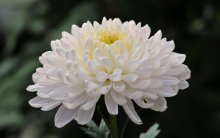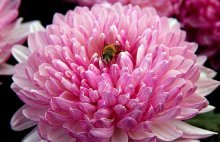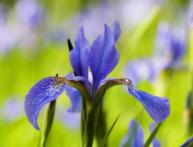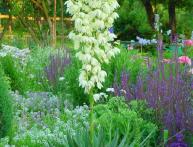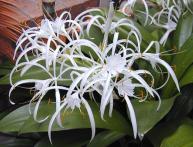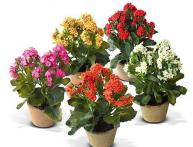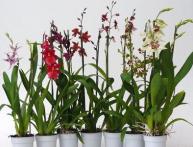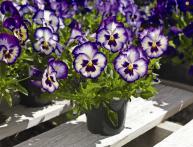Homemade chrysanthemum: care and proper planting

One famous writer said: “When I hear the word “chrysanthemum”, I see an elegant lady with a thoughtful smile, dressed in luxurious, white furs.” And indeed, white, lush chrysanthemums look like noble ladies, while multi-colored ones are medium-sized chrysanthemums - for cheerful young ladies. Both are worthy of long-term admiration.
It is not in vain that so many poems and romances were dedicated to them. “The chrysanthemums in the garden have faded a long time ago...” But even if the chrysanthemum in the garden has finished flowering, it is easy to grow in a pot, and it will delight you with its warmth all year round. In order for the flower to be comfortable, you need to know what the domestic chrysanthemum prefers and what care it needs. These questions will be covered here.
Content:
- Description of the plant
- First meeting or where to buy homemade chrysanthemum
- Everything a beauty needs
- Reproduction
- Possible difficulties
- Diseases and pests
Description of the plant
Everyone is familiar with this plant with light green leaves, which have different shapes and are arranged alternately. This flower surprises with the variety of its species. There are perennial and annual chrysanthemums, with small and large flowers, with simple and double buds, with single flowers and with a whole basket of inflorescences, with every possible color palette.
This beauty can grow and in open ground, and at home, being content with an ordinary pot. There are a great many varieties of chrysanthemums, it is extremely difficult to list them, so it is suggested to look at how these flowers are classified:
- By flower size - up to 80 mm chrysanthemums are considered small-flowered; larger than this size are large-flowered
- by tier - double-row (flower petals are arranged in two rows), double and semi-double
- by flowering time - early flowering, middle and late (if there is a need to obtain seeds, this information is important, late varieties do not have time to produce full-fledged seeds)
- in size - up to 30 cm in height, these are border chrysanthemums, and up to 50 cm - medium chrysanthemums
To keep the flower in home pots, varieties of low-growing chrysanthemums are used, however, the shape, color and size of the flower itself may vary. Most often, such pets grow no higher than 15-18 cm, and have luxurious foliage and rich caps of inflorescences.
Particularly in demand are varieties such as “Minimum” - low bushes with bright flowers, the “Charm” series, in which there are inflorescences of different colors, and the hanging varieties “White Cascade” and “Pink Cascade”. Korean chrysanthemums are very good, they form entire flower balls. These are varieties such as “Navare”, “Stella”.
Exclusively homemade sissies - Indian chrysanthemums, varieties “Snow Elf”, “Aurora”, “Ellen”. These varieties are bred exclusively for indoor soil and are ideal for potting.
First meeting or where to buy homemade chrysanthemum
There are several ways to get hold of this blooming beauty.
- Grow from seeds
- Borrow from friends
- Buy a flower in a specialized pavilion
The first method is the easiest.The flower itself is already visible in all its glory, all that remains is to buy it, bring it home and provide proper care. However, most often it turns out that in stores, having met a blooming beauty, they immediately buy it, not paying attention to some important factors. But it depends on them whether the flower will delight the owner for a long time or will die immediately after purchase.
To avoid troubles, when purchasing you should pay attention to the following:
- All stems and leaves must have a healthy color, be developed, and the leaves must be located proportionally on the stem.
- Yellowing, curvature of the bush, bent or twisted shoots are a sign of ill health.
- The plant must be clean from insects (especially it is worth looking at the inside of the leaf).
- The flower should be strong, dense, compact.
- The soil should not lag behind the walls of the pot (if this is the case, perhaps the plant has just been moved and how it will take root is a question).
The most important thing is that you like the flower. After the plant is purchased and brought into the house, you need to quarantine it, that is, put it where there are no other plants. This will protect existing green pets from possible diseases, and it will be more convenient for a beginner to get used to it.
Everything a beauty needs
Light
This flower requires short daylight hours, because it is not for nothing that most varieties of open ground begin to bloom closer to autumn, when the days become shorter and the weather is cooler. Chrysanthemum feels most comfortable with 8-10 hours of daylight and in the absence of strong heat.
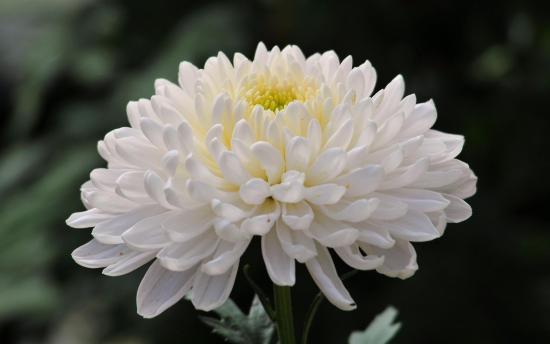
In nature, this happens not only in autumn, but also in spring (April).Therefore, if the house beauty is moved to a balcony or loggia at this time, it will be able to bloom twice - in spring and autumn. You can “deceive” the plant and force it to bloom when you want, if you cover it with a thick cap (create a shortened daylight hours) and provide temperature conditions.
Temperature
For this flower there are clear temperature limits when the plant feels most comfortable.
- Winter - 3-9 degrees Celsius
- Autumn (spring) – 15-18 degrees above zero
- Summer – 20-24 degrees
If such conditions are created, the chrysanthemum will produce the largest number of buds, and its flowering time will last much longer, because it will have time to rest well and gain a lot of strength. And yet, not every flower lover will rush around the house with a thermometer, and this is not necessary. Chrysanthemum It tolerates some temperature fluctuations well, feels great outdoors in summer and can even tolerate frosts down to -2 degrees.
Priming
If the plant was purchased in a container, you should wait for it to bloom, and then transplant it into a new, larger pot. This means that you will need soil for this. The easiest way is to buy a ready-made substrate for chrysanthemums. But if you can’t buy it, you can cook it yourself. To do this you need:
- turf soil - 2 parts
- humus - 1 part
- leaf soil - 1 part
- coarse sand - 1 part
In such a soil mixture, a green pet will feel even better than in purchased soil.
Watering
One of the main factors in flower health is proper watering.Dryness will lead to wilting and the appearance of pests (spider mites), and excess moisture will contribute to rotting of the roots or the appearance of fungal diseases.
First, you should put drainage in the pot so that moisture does not accumulate at the roots. You need to water twice a week, however, you should approach this wisely.
If the room is dry and hot (radiators dry out the air very much in winter), more watering is required, but if the house is cool, you should not be overzealous with watering. Before watering, you should inspect the soil; if it is wet, you should not water it, but if the top layer is dry, you need watering.
Tap water cannot be used for irrigation; it must sit for at least 2 days. The water temperature should not be lower than room temperature. To create a wet area near the flower, you need to spray the plant. This will also be a preventive measure against spider mites.
Feeding
For luxurious flowering, the plant requires a lot of strength, but the soil is not able to provide the flower with all the necessary substances, so it is necessary to feed the chrysanthemum. Feeding should begin from the vein, because in winter the plant rests.
Video on how to properly plant a chrysanthemum:
Ready-made fertilizers can be bought at any store; the packages provide detailed instructions for use. Fertilizers are applied once every ten days.
Reproduction
Propagating chrysanthemums is not at all difficult. Two methods are especially suitable:
- shoots
- cuttings
With good care, the chrysanthemum bush grows so abundantly that you can easily separate 5-6 shoots, which very quickly form an independent plant.To do this, the shoots are simply transplanted into a separate, small pot and provided with good watering. With this propagation, the new bush begins to bloom within a few months after planting.
Cuttings are also a fairly simple method. Branches up to 10 cm in size are cut from the mother bush, the sections are treated with a root-forming substance (kornevin), and then planted in pots and covered with a plastic cup or film. This cup will need to be cleaned periodically to prevent mold. Cuttings roots quickly form, after which the glass should be removed altogether.
Possible difficulties
Chrysanthemum does not bloom
From the article it is clear that flowering requires a certain daylight hours and the right temperature. That is, the flower blooms only in autumn, sometimes in spring. But if even at this time the flower refuses to please with its beauty, it means that mistakes were made in caring for the green pet.
The leaves wither or the plant dries out
First of all, you need to check that watering is correct, and then inspect the plant for pests. Ensure proper watering; in addition, it is very important to remove all dried leaves from the flower, otherwise the plant may be lost.
Diseases and pests
Like any living organism, chrysanthemums are susceptible to diseases and pests can bother the flower.
Spider mite
More than other pests, spider mites love chrysanthemum leaves. After this parasite appears on the plant, the leaves turn yellow, curl, and small black or brown dots that move can be observed on the inside of the leaf. The entire infected surface of the leaves and even the stem are covered with small cobwebs.
If you do not get rid of the mite, the plant dies quite quickly.This pest really does not like water, so the plant must be washed well with soap and water, then rinsed in the shower. This procedure should be done repeatedly. Good prevention against tick is frequent spraying.
Other diseases
Gray rot. With this disease, a gray, fleecy coating appears on the leaves. In order to get rid of the disease, it is necessary to use foundationazole.
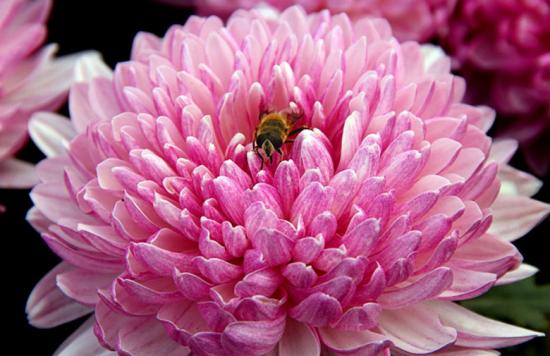
Powdery mildew. A fungal disease that causes the leaves to become covered with a gray coating. The disease is treated with fungicides. With this disease, you should put the pot with the plant away from other flowers.
Septoria. Appears from excess moisture, abundant watering. Leaves with this disease are affected by brown spots. It is necessary to reduce watering and treat the bush with foundationazole.

